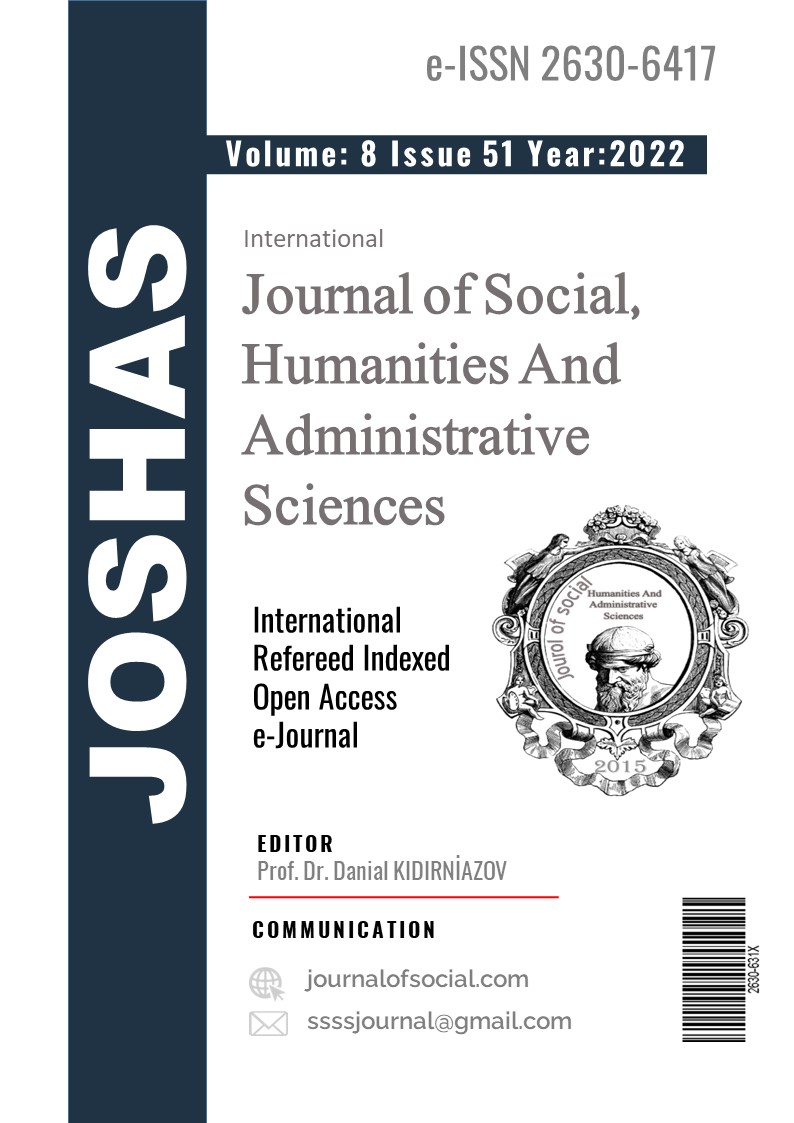Author :
Abstract
Harfler, konuşma dilindeki sesleri betimleyen soyut formlardır. Bu soyut formlar; görsel ve uygulamalı sanatlardan, toplumsal değişimlerden, endüstriyel ve teknolojik gelişmelerden etkilenmiş ve dönemin gereksinimlerine cevap veren bir uyumla değişimlere uğramışlardır. Harflerde tarihi süreçler, her harfin kendisi için yeni formlar bulmaya çalıştığı bir gelişim sürecini ifade eder. Yeni olan her süreç, temel ilkelerini belirleyen mekanik bir üretim süreci olmuş ve aynı zamanda daha önce var olan harf formları ile etkileşime girerek, yeni çeşitlemelerini geliştirmiştir. Bu tarihsel ilerlemeler boyunca büyük harf yapıları antik Roma yazıtları ile başlayan klasik orantısal sistemden, modern orantısal sisteme doğru evrilmiştir. “Klasik orantısal sistem” antik kökenlidir; geometrik kare ve karenin bölümleri ile yapılandırılmıştır. Harflerin genişlikleri numerik olarak eşit ve birbirine yakındır. “Modern orantısal sistem” harflerin genişliklerini etkileyen dikdörtgen ve elips geometrik formlar içerisinde yapılandırılmıştır. Bu nedenle modern orantısal sisteme ait geometrik yapı özelliği, en dar harflerden en geniş harflere kadar olan bir skalada farklı genişliklere sahip harf tasarımlarını olanaklı kılmaktadır. Ağırlıklı olarak geometrik yapının aktif olduğu; klasik ve modern iki farklı orantısal sistem ve döneme ait harf yapılarının analizinde, iki dönemin gerçekte benzer kökenlere sahip oldukları görülmektedir. Bu makalenin amacı; farklı süreçleri temsil eden klasik ve modern orantısal sistem harf yapılarının, tasarımda ortak geometrik yaklaşımlara sahip oldukları gerçekliği konusunu, dönemlerin yazı tasarımcıları ve tasarladıkları harflerin analizleri aracılığı ile sunmaktır.
Keywords
Abstract
Letters are abstract forms that depict sounds in spoken language. These abstract forms have been influenced by visual and applied arts, social changes, industrial and technological developments, and have endured changes in harmony meeting the needs of the period. The historical processes in letters express a developmental process in which each letter casts around to discover new forms for itself. Each new process has become a mechanical production process that determines its basic principles and also has interacted with the pre-existing letterforms and so developed new variations. During these historical developments, capital letter structures have evolved from the classical proportional system, which started with the ancient Roman inscriptions, to the modern proportional system. The “classical proportional system” originates from the ancient root; it was structured with geometric square and segments of the square. The widths of the letters are numerically equal and close to each other. The “modern proportional system” was configured in rectangular and elliptical geometric forms affecting the widths of the letters. For this reason, the geometric structure feature of the modern proportional system yields letter designs with different widths on a scale that is from the narrowest letters to the widest letters. In the analysis of two different proportional systems that are classic and modern and the letter structures belonging to the period that predominantly geometric structure is active, it is observed that the two periods actually have similar roots. The aim of this article is to present the authenticity of the subject that the classical and modern proportional system letter structures, which represent various processes, have common geometric approaches in design, by means of the writing designers of the periods and the analysis of the letters they designed.
Keywords
- Brown, A. (1989). in Print: Text and Type (1. bs.). New York: Watson-Guptill Publications.
- Brown, A. (1989). in Print: Text and Type (1. bs.). New York: Watson-Guptill Publications.Burke, C. (1998). Paul Renner: the art of typography. London: Hyphen Press.Carter, R. Day, B. & Meggs, P. (1985). Typographic design: Form and Communication (1. bs.). New York: Van Nostrand Rainhold Inc.
- Cheng, K. (2005). Designing Type (1. bs.). Yale University Press.
- Codex99 (2011 December 29). The Trajan Inscription. Codex99. Erişim: 21 Aralık 2021. http://www.codex99.com/typography/21.html sitesinden.
- Fast Company magazine (2008, October 01). Masters of Design. Evolution of a Typeface: Neutra. Erişim: 03 Kasım 2021. https://www.fastcompany.com/1007973/evolution-typeface-neutra sitesinden.
- Feliciano, F. (1960). Alphabetum Romanum. (G. Mardersteig, Ed.). Verona: Editiones Officinae Bodoni. (Original work published 1463)
- Garg, C. (2019, March 01). Historia of Type-The Capitalis Monumentalis. Charchitgarg. Erişim: 09.01.2022. https://charchitgarg27.medium.com/historia-of-type-the-capitalis-monumentalis-b53da6863807 sitesinden.
- Gorman, M. J. (2002). Leonardo Science Technology and Art. Erişim: 08.02.2022 http://leonardodavinci.stanford.edu/submissions/clabaugh/history/vitruvius.html sitesinden.
- Gray, N. (1986). A history of lettering: creative experiment and letter identity. Oxford: Phaidon. Harvey, M. (1980). Lettering Design. New York: Bonanza Books.
- Holliday, P. (2002). Eric Gill’s photograph album ‘Rome 1906’. (P. Holliday, Ed.). “Eric Gill in Ditchling: four essays”, (1-28). New Castle, Delaware: Oak Knoll Press.
- Kızılçelik, S. (1994). Postmodernizm: Modernlik Projesine Bir Başkaldırı, Türkiye Günlüğü Dergisi, sayı: 30. ss. 36-96. Ankara: Cedit A.Ş.
- Knuth, D. E. (1999). Digital Typography. Cambridge University Press.
- Smith, N. (2011, December 19). Influences-Geometric Type II. Nadinechicken. Erişim: 15 Aralık 2021. https://nadinechicken.wordpress.com/2011/12/19/influences-geometric-type-ii/ sitesinden alındı.
- Tory, G. (1967). Champ fleury. (George B. Ives, Çev.). New York: Dover Publications, Inc.
- Tubaro, A. & Tubaro, I. (2002). Lettering: studi e ricerche. Milano: Ulrico Hoepli Editore S.p.A.
- Typedia (n.d.). Neutraface, Erişim: 03 Kasım 2021. Typedia. http://typedia.com/explore/typeface/neutraface sitesinden.
- Verini, G. B. (1947). Luminario; or, the third chapter of the Liber elementorum litterarum on the construction of Roman capitals. Cambridge: Harvard College Library; Chicago: The Newberry Library.
- Violatti, C. (2015, Şubat 05). Yunan Alfabesi (İrem Martı, Çev.). World History Encyclopedia. Erişim: 13 Mart 2021. https://www.worldhistory.org/trans/tr/1-13526/yunan-alfabesi/ sitesinden.
- Zıllıoğlu, M. (Aralık 2020). İletişim Nedir?. (7. bs.). Cem Yayınevi, Konak, İzmir Şekiller
- Devroye, L. (2021, April 29). Romain du Roi. Luc Devroye. Romain du Roi. Erişim: 02 Eylül 2021. http://luc.devroye.org/fonts-89919.html sitesinden.
- Fabrizi, M. (2019, October 27). The Underlying Structure of Letters: Luca Pacioli’s Alphabet from De Divina Proportione (1509). Socks. Erişim: 22 Eylül 2021. https://socks-studio.com/2019/10/27/letters-alphabet-pacioli/ sitesinden.
- House Industries (n.d.). neutraface text. Neutraface. Erişim: 02.02.2022. https://housefonts.com/hi/neutraface sitesinden.Padovan, G. (2021, March 06). Castello di Milano: dall’Uomo Vitruviano all’ominide incivile. Archeologia del Sottosuolo.Erişim: 05 Şubat 2022. https://www.archeologiadelsottosuolo.com/castello-di-milano-dalluomo-vitruviano-allominide- incivile-ottava-puntata/ sitesinden.
- Viatour, L. (2007). Lucnix. Erişim: 27.02.2022. https://lucnix.be/picture.php?/113554/category/leonardo-da- vinci&metadata sitesinden.





